Best Revenue Operations Software – 2026 Review
Revenue operations brings sales, marketing, and customer teams together under one strategy to boost profits.
Companies need RevOps software to run these processes smoothly.
It brings together tools for customer tracking, project planning, and financial management in one place.
This guide will help you choose the right revenue operations software by comparing top options and highlighting what makes each one unique.
How to Choose Your Revenue Operations Software?
The most important thing for supporting your revenue operations is ensuring that your data is centralized. An ideal revenue operations software is an all-in-one tool which combines several functionalities, such as:
- Robust reporting and forecasting
- Budgeting and financial management
- Customer lifetime management
- Workflow automation
- Third-party integrations for a unified tech stack
Other important criteria include scalability, user interface, and customer support. If the tool performs poorly on these three levels, this can impact adoption. Ultimately, it means that you won’t be able to get the most out of your RevOps software and see a real impact.
Our List of the 10 Best RevOps Tools
1. Productive – Best Revenue Operations Platform for Agencies
Productive is the ideal tool for taking a holistic approach to your business management
It’s designed to integrate key professional services workflows into one platform. This helps your teams focus on a common goal and make data-driven decisions based on unified data.
Some of Productive’s key features includes lead mangement with an integrated CRM, financial management with budgeting and billing, project and task management, and customizable reporting.
Let’s explore these key features in more detail.
Try Productive’s RevOps software
Sales CRM
Productive offers a lightweight sales CRM to bridge the gap between your project management and the sales strategy.
You can use it to set up custom stages for your sales funnel and update the status on deals. You can also set stages on deals as won and lost, manage reasons for lost deals, and then combine this with other metrics to get actionable insights.
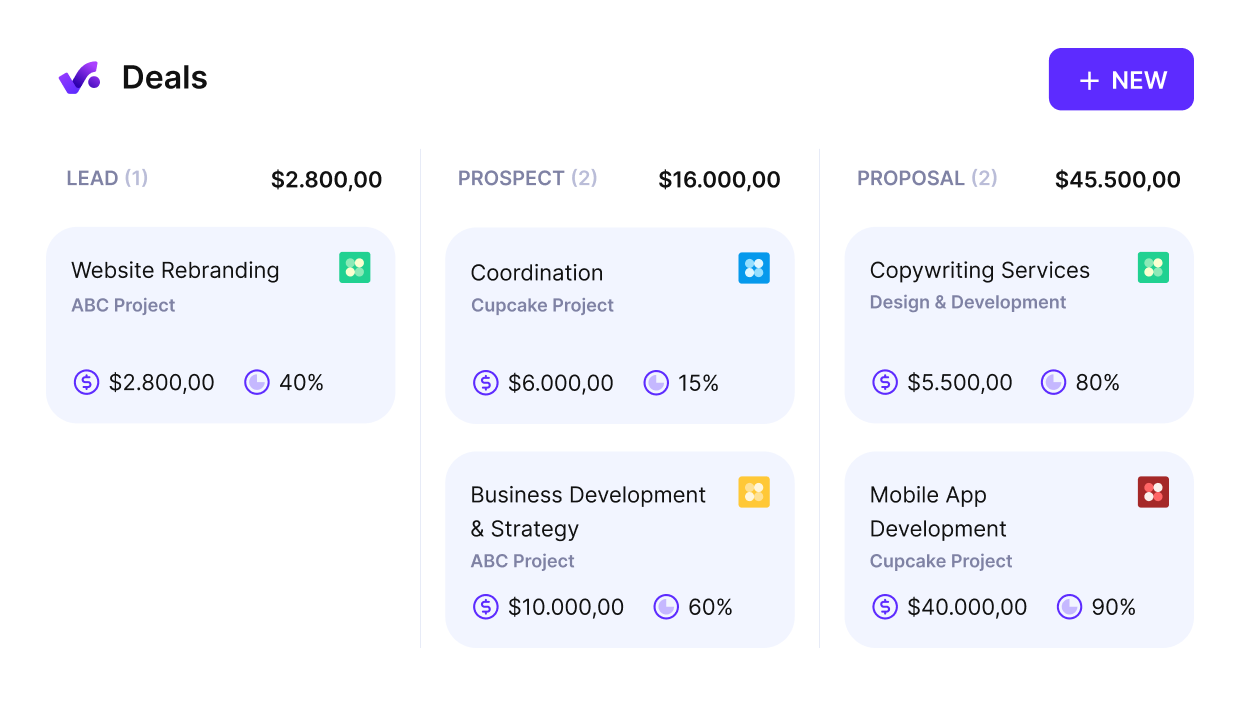
Manage the entire customer lifecycle
The CRM feature is connected to budgeting, so you can use agency rate card data to create and send proposals to clients easily. Run your entire sales process, by then converting won deals into projects.
You can also:
- Schedule your sales teams to manage their availability and workloads
- Get sales forecasting, including revenue and profitability
- Collaborate with team members with tasks and TODOs
Learn how to make a quote that’s brand-friendly and professional.
Financial Management
Productive offers advanced features for tracking revenue-generating activities. Our advanced analytics help you make data-driven decisions that support business growth.
You can define your agency rates, build rate cards, create budgets (fixed, hourly, retainer), and monitor every aspect of your project finances (such as customer acquisition costs).
For revenue recognition, choose between two ways of reporting from fixed services — spread across time or recognized on a single date.
This also includes financial forecasting. By scheduling your resources (each with their associated costs), you can view your revenue and profit margins ahead of time. This provides you with data-driven insights at every step of your project execution so you can control scope creep and get reliable project progress information.
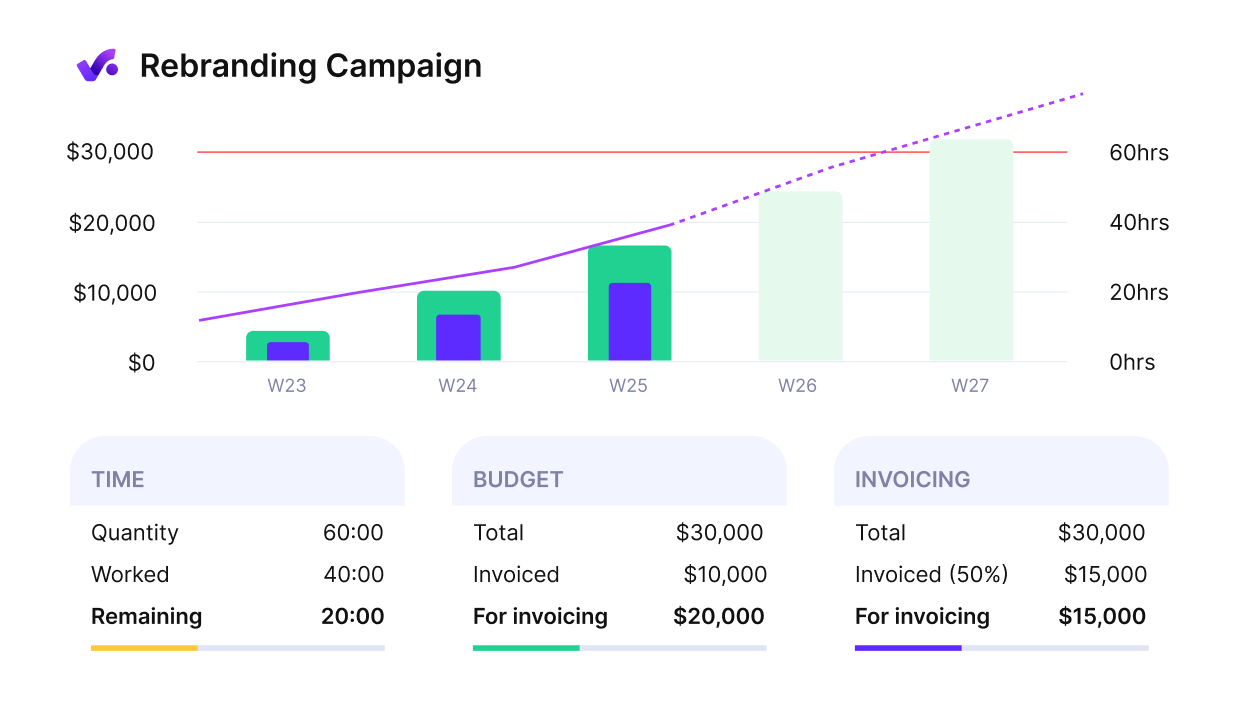
Manage and visualize your revenue performance with Budgeting
With Productive, you can also track billable hours. This data is used to create client invoices on the platform, but you can also use Productive’s Xero or QuickBooks integrations to finalize your billing.
Projects and Tasks
Manage your market strategy, streamline repetitive tasks, and get a 360-degree view of your projects with Productive.
With the Project Management feature, you can switch between multiple project views, including Kanban, Gantt, Workload, and more. Collaborate with teammates on tasks with dependencies, subtasks, and todos, estimate completion times, and add other custom task fields.
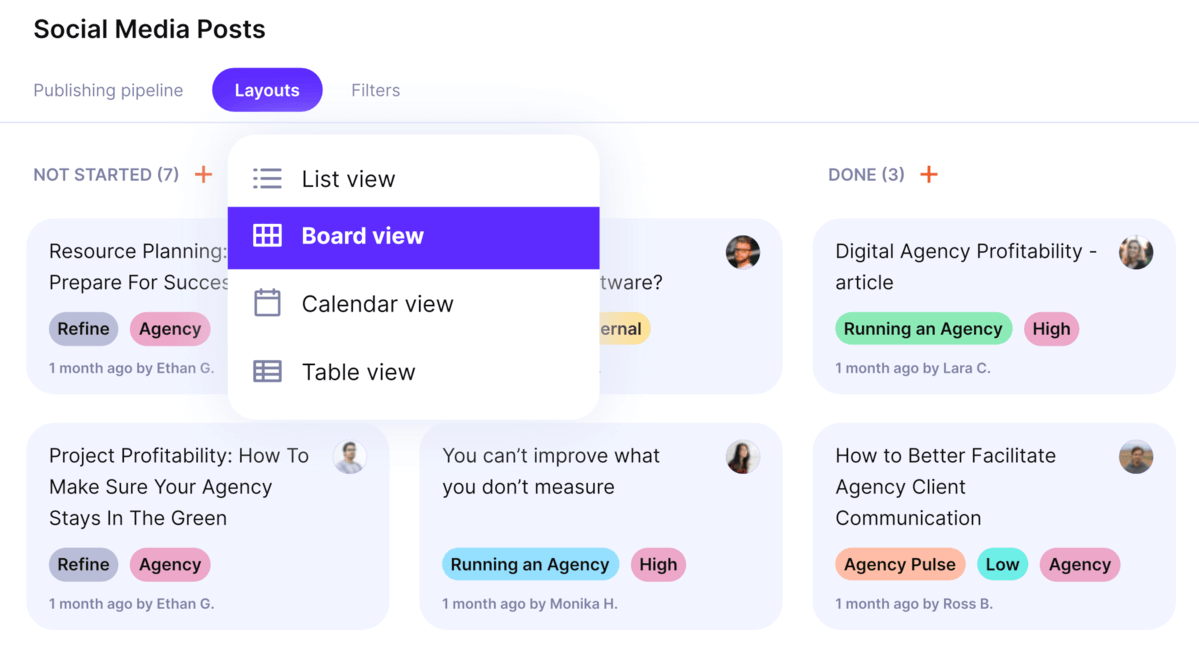
Support collaboration with customizable project layouts
You can also create and share documentation with Docs, create no-code automations, and set up custom permissions to control who can see and do what.
Reporting
Productive’s Reporting pulls data from multiple platform sources, including time tracking, budgeting, resource planning, invoicing, and more. You can create reports by using one of the 50+ agency-focused templates or by building your own from scratch. Use custom fields to add agency-specific parameters and choose whether you want to depict your report as a data table, chart, or both.
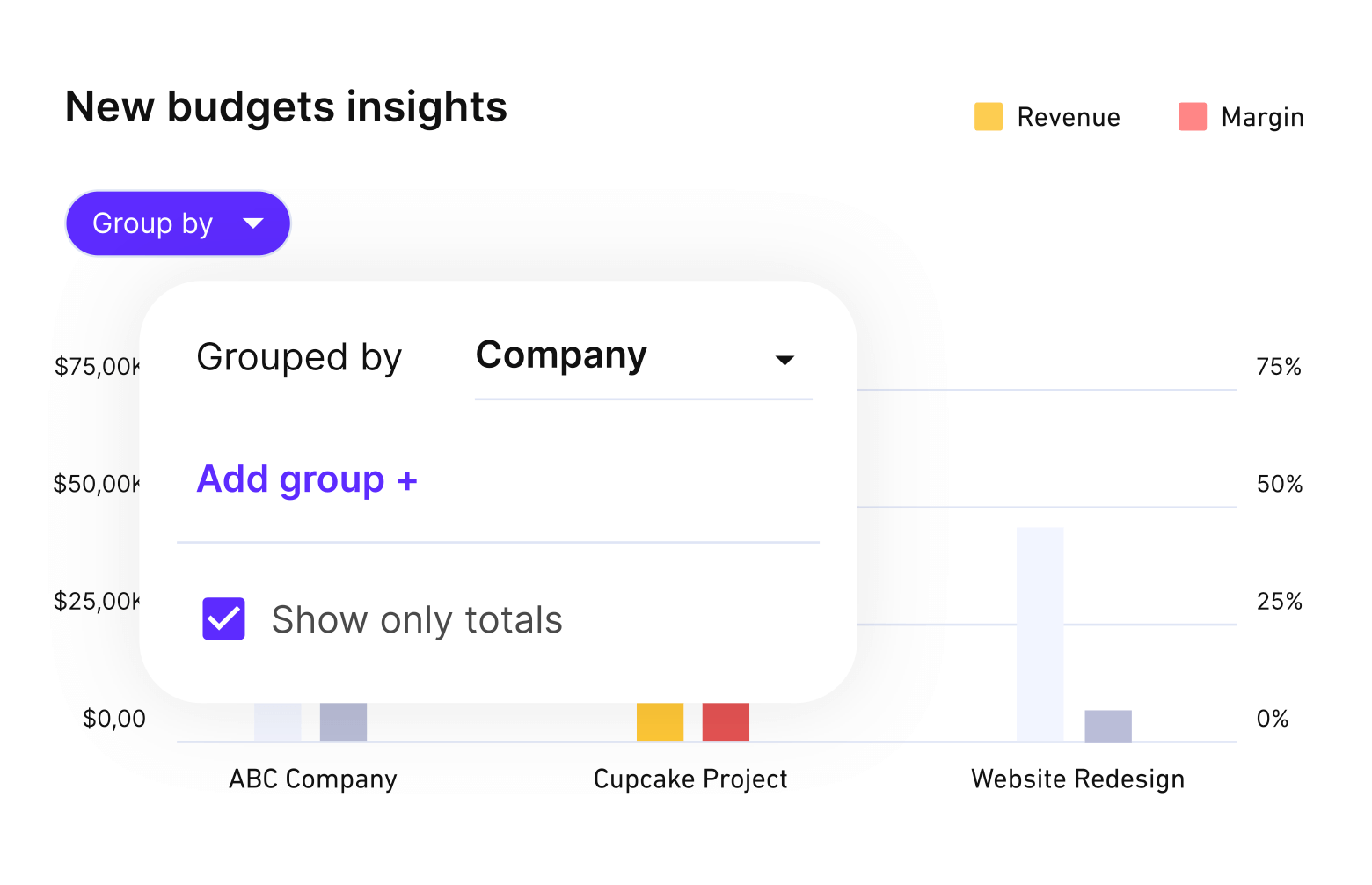
Filter and group your financial data
To share reports, you can also create custom dashboards and add widgets to them. You can also set up automatic sharing to email or Slack.
Additional Features
- Resource planning: Manage employee availability and workloads, allocate and reallocate their time, and visualize and forecast utilization.
- Time off management: Set up time off categories across employees and handle leave requests across the platform.
- Time tracking: Track time with an integrated timer (also available as a desktop widget), through manual entry, or by automatic creation by syncing them with resourcing.
Integrations
Productive offers a range of native integrations for a more seamless tech stack.
Some options include Xero and QuickBooks for accounting; Slack, Google Calendar, and Memtime for collaboration and timetracking; Breathe and BambooHR for HR management; HubSpot, Jira, Zapier, and many more.
Pricing
- Plans start with the Essential plan at $9 per user per month, which includes essential features such as budgeting, project & task management, docs, time tracking, expense management, reporting, and time off management.
- The Professional plan includes custom fields, recurring budgets, advanced reports, billable time approvals, and many more for $24 per user per month.
- The Ultimate plan has everything that the Essential plan and Professional plan offer, along with the HubSpot integration, advanced forecasting, advanced custom fields, overhead calculations, and more for $32 per user per month.
Productive offers a 14-day free trial, so check it out to see what the platform can do for your business.
Manage Your Revenue Operations With Productive
Align your teams and centralize key data with an all-in-one agency management software solution.
2. Clari – A Leading Revenue Operations Platform
The Clari revenue platform is a leading provider of solutions for supporting revenue teams. This includes modules such as Copilot for call recording during the sales process, Forecast for predictive analytics, and Groove for email templates, automations, and more.
Key features:
- Various modules to support the revenue pipeline
- Control and support the end-to-end revenue process
- Reliable insights for RevOps teams
- Designed for healthcare, tech, financial services, manufacturing, and more
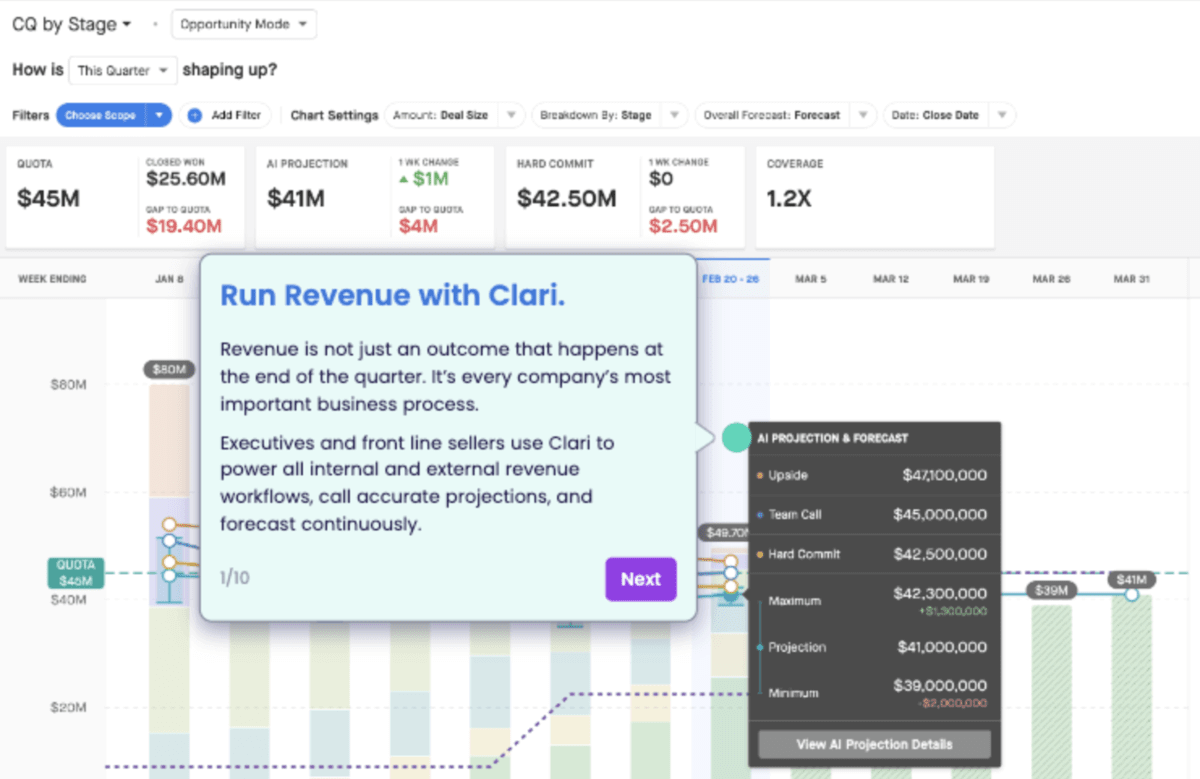
SOurce: clari
Users enjoy that Clari can give them a “holistic view of your business” (Source: Reddit). The platform has overall positive reviews on G2, though many users state that reporting could be more advanced. Some have reported that they need to supplement their insights with additional tools.
Additionally, Clari doesn’t offer transparent pricing, which means you’ll need to get in touch with the sales team to find out their pricing. This fact, alongside its many modules, can complicate your decision-making process.
3. Gong – A Solid Option for Managing Customer Interactions
Gong is an artificial intelligence platform for sales, customer success, and marketing teams built on customer interactions. It supports revenue growth by analyzing sales operations and customer experiences.
Key features:
- Forecasting and pipeline management
- Customer interactions critical insights
- Sales performance management
- 70+ languages for global teams
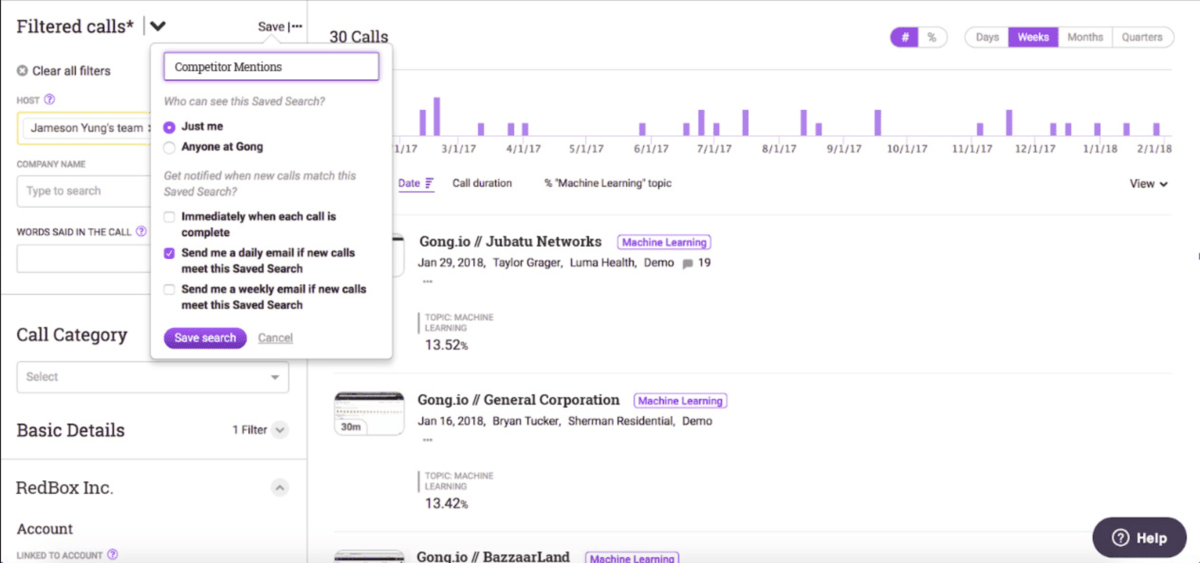
Source: gong
Gong’s core feature is built around customer interaction recording and insights. It can be a valuable tool if you’re interested in managing your sales reps and improving performance. However, there’s not much in the way of marketing work management or general revenue tracking (for ex., project budgeting or invoicing).
While Gong is certainly a nice-to-have sales enablement tool, it won’t be necessary for most teams. Some users also find Gong to be pricey for what it’s offering:
They’re the most expensive tool of their kind and you can get the same call recording/transcript software bundled in with other software packages.
Source: Reddit
4. Salesforce CRM Analytics – An Advanced Business Intelligence Tool
Salesforce CRM Analytics, previously known as Tableau, is a reporting tool that translates data into visualizations to provide valuable insights into key performance indicators.
Key features:
- Data visibility and integration
- Visualizations and custom dashboards
- AI suggestions and automations
- Integrates with other Salesforce products

source: salesforce crm analytics
Tableau is a powerful business intelligence solution that helps business leaders make informed decisions and take a strategic approach to their business management. Tableau isn’t the most complicated reporting tool out there, but it can be on the harder-to-learn side. Businesses that want to invest in Tableau will want to consider hiring for a project analyst role or a similar professional who’s well-versed in using the tool.
Additionally, some users have reported issues with customer support after Tableau was acquired by Salesforce.
I first started using Tableau about 12 years ago. The support side of things is night and day from then till now. I had already noticed a shift before Salesforce, but that really accelerated the decline.
Source: Reddit
5. HubSpot – A Popular Marketing Management Software Solution
HubSpot is a CRM platform for marketing agencies, sales teams, and customer success teams. It offers multiple different modules, called Hubs, across different industries and business needs.
Key features:
- Campaign and web analytics tracking
- Customer journey and attribution
- Customizable marketing dashboards
- Integrated email and ad campaigns

source: hubspot
HubSpot is a well-known marketing agency software, and a common competitor to Salesforce in the same bracket. According to some user reviews, HubSpot is generally more pricey than Salesforce, but simpler to use. On the other hand, the reporting functionalities might be lacking in comparison.
I’ve used Hubspot and Salesforce as CRMs and while I love the reporting capabilities of SF, Hubspot is all round better IMO – especially for smaller teams. I love how the forms, documents, meeting bookings, landing pages, etc. all tie in together on the contact records. Much easier to understand than SF too, I found.
Source: Reddit
While tools such as HubSpot or Salesforce can be great for customer relationship management and sales enablement, you’ll also need to consider implementing an agency management tool to handle projects and budgeting.
6. Kluster – A Solid Marketing Reporting Platform
Kluster is a revenue intelligence platform that helps SaaS companies achieve revenue growth targets with advanced strategy, planning, and execution tools.
Key features:
- Revenue recognition and forecasting
- Reports library with real-time analytics
- Scenario planning tools and goal tracking
- Integrated sales and financial insights
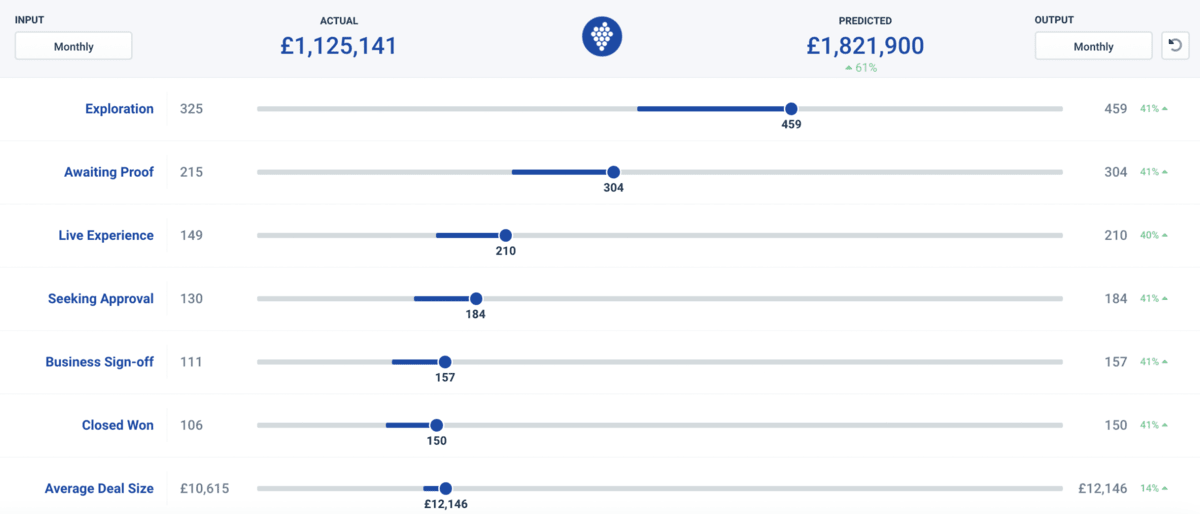
source: kluster
Kluster is a management software focused on providing forecasting and predictive analytics. It connects to your CRM to analyze historical data and predict revenue using AI. For example, Kluster can be integrated with HubSpot to provide more reliable forecasting software and sales productivity management.
The platform has overall positive features on review websites. The only downside is that it will increase your tech stack rather than decrease it, as it’s designed to complement a more robust CRM platform.
7. Aviso – A Good Addition to Business Tech Stacks
Aviso is a revenue operations software for sales, marketing, and customer support teams. It offers integrations with HubSpot, Salesforce, SAP, and other CRM software.
Key features:
- Data source integration and syncing
- Aviso Graph for managing user relationships
- NLP analytics and deal prediction
- CRM data hygiene management
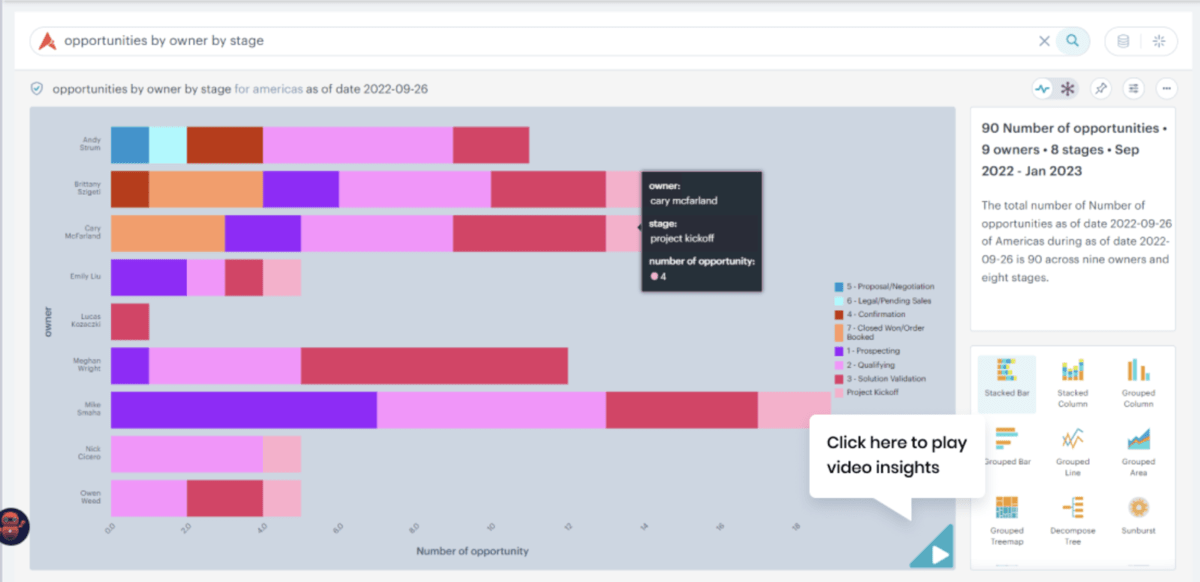
source: aviso
Users report that Aviso helps them make sense of their revenue operations metrics and get the most out of their CRM systems. It’s a tool that can synergize well with your RevOps tech stack.
As a downside, a review on G2 reports that the implementation is more hands-on than with some large SaaS providers, so keep in mind that you’ll need to invest time into getting the most out of this revenue intelligence software.
8. 6sense – A Good Account Tracking Platform
6sense revenue AI offers distinct revenue operations tools for sales teams and marketing teams. The marketing solution offers capabilities such as data enrichment and audience building, while the sales solution offers account intelligence and workflow prospecting.
Key features:
- Platforms for sales and marketing
- B2B dataset management and account identification
- AI-driven insights on revenue streams
- Integrations with other marketing & sales enablement platforms
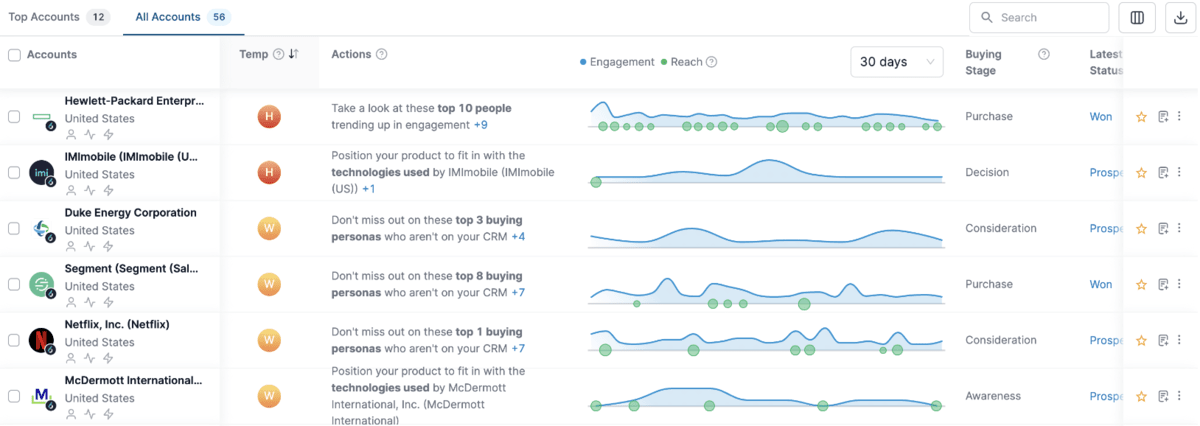
source: 6ense
Although Sisense is fairly well-reviewed, customers report issues with inaccurate or missing data.
Frequently I see great activity on an account but 6Sense can’t identify who was doing the searches or viewing our website. They will usually be listed as an “anonymous user” which can make it difficult to find the right person to connect with.
Source: G2
When it comes to its good sides, users enjoy that the platform is designed to support not only marketing workflows but also sales and ops. The tool is reported to be simple and straightforward to use.
9. Weflow – A Solid Tool for Salesforce Users
Weflow is a sales pipeline management and forecasting tool that helps RevOps leaders and their teams get the most out of Salesforce with a streamlined interface.
Key features:
- Two-way Salesforce integration
- Real-time sales metrics and forecasting
- Sales performance management
- Pipeline visibility and change tracking
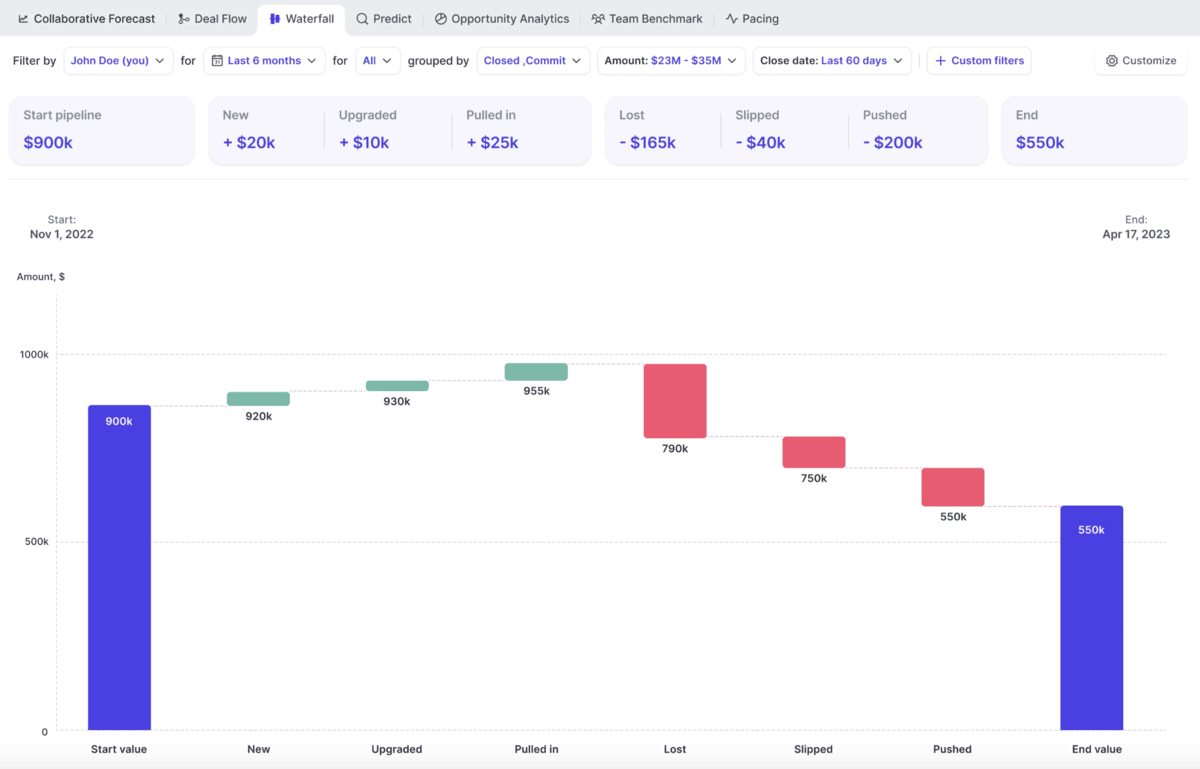
source: weflow
If you’re already using Salesforce to manage your sales and marketing processes but are having issues managing your data, Weflow is a fair option.
This software is very easy to use and has greatly reduced the time I spend on administrative tasks. Internally, we use Salesforce, but updating opportunities, forecasts, and accounts is often time-consuming, in addition to problems with write access and a lack of intuitiveness.
Source: G2
10. Revenue Grid – An Alternative Option for Salesforce Users
Revenue Grid is another revenue operations solution that integrates with your CRM and marketing automation tools to improve data management and accuracy.
Key features:
- Built-in Salesforce and email integration
- Syncs Salesforce with Gmail and Outlook calendars
- Automatic data capturing
- Performance and revenue reports
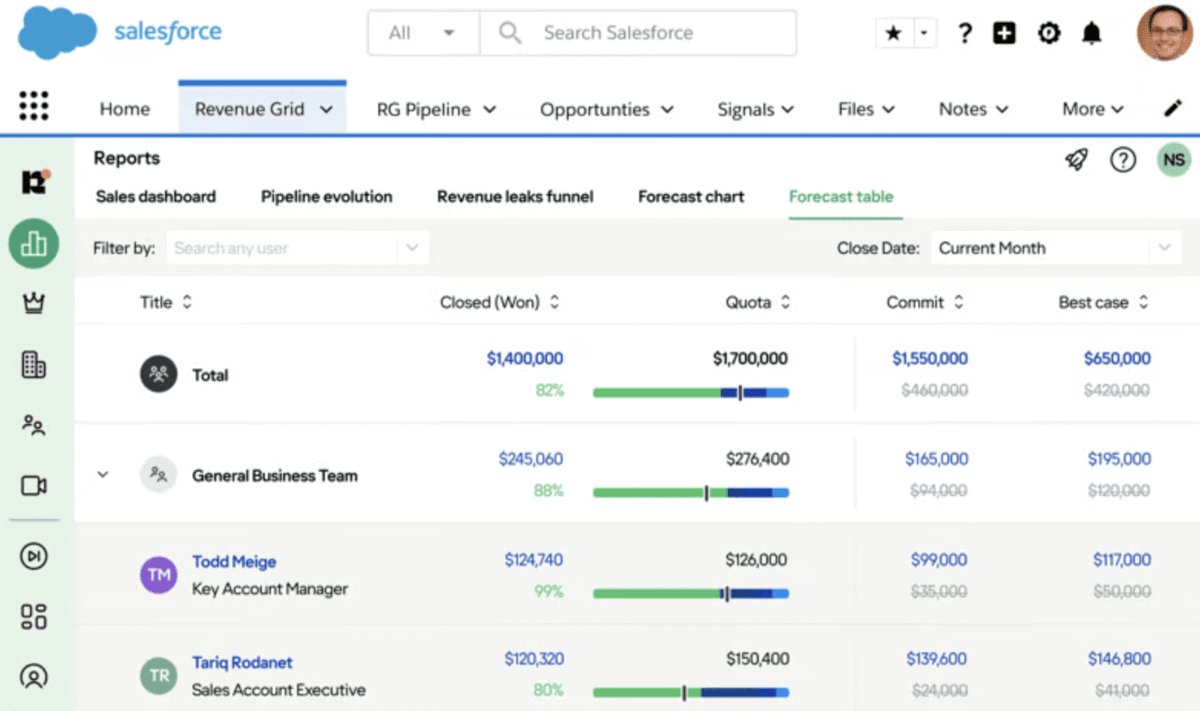
source: revenue grid
Revenue Grid offers integrations with a handful of CRMs. The most notable one is Salesforce, which can be a nice-to-have option for syncing your data and simplifying processes. Users often enjoy the fact that it syncs with the Gmail suite. Like Weflow, it’s a solid addition to your tech stack.
Key Revenue Operations Platforms Features
Key features of revenue operations (RevOps) platforms include:
- Data integration to allow for unified and reliable data from a single source
- Real-time insights into revenue and profit margins
- Customizable dashboards and reporting templates
- Customer relationship management and team collaboration
- Automation features for streamlining repetitive tasks
How to Choose a RevOps Tool?
To choose revenue operations software, consider what option best resolves your pain points. Are you looking for a tool that can fit into your current tech stack? Or are you interested in reducing the number of tools you have for a more comprehensive solution?
Another important thing to consider is user design and customer support. Software which offers a free trial can be a great option to help you get some first-hand experience into features and usability.
For scalability, consider how active the vendor is on their website, roadmap, and/or social media. A tool dedicated to polishing and upgrading its experience is usually a better choice than a legacy solution, as it ensures you’re using the most advanced and modern solutions for your workflows.
Benefits for Revenue Operations Teams
According to research by Mint Jutras, the benefits of implementing a revenue operations tool include:
51% of teams get better access to their data. When sales teams need customer information or marketing wants to check campaign results, they find it fast. Productive.io puts all this data in one place, so teams spend less time searching and more time working.
34% of companies see their teams work better together. For example, when sales closes a deal, marketing instantly knows which campaigns brought in that customer. Teams using Productive share updates in real time, making decisions faster.
23% deliver projects faster and better. With clear data, teams spot issues early and fix them quickly. Productive shows exactly where projects stand, so managers adjust resources right away to keep work moving.
23% say their employees get more done each day. Instead of jumping between different tools or waiting for updates, teams have everything they need to work efficiently. Productive automates routine tasks, giving teams time to focus on important work.
Why do these types of tools have such an impact?
Revenue operations software enhances data accessibility and availability by centralizing information to a single source of truth, making it easily accessible for all team members. This supports improved internal collaboration, as teams can effortlessly share and access the same data. This leads to better delivery quality, reduced turnaround times, and increased employee productivity.
Final Thoughts: Which Tool to Choose?
When researching revenue operations solutions, prioritize those that centralize data, integrate well with existing systems, and offer robust reporting and automation features.
A tool such as Weflow or Revenue Grid can be a good addition to your existing CRM solutions. Others, such as Gong or 6sense, can be a great specialized platform for sales or marketing teams.
Productive, with its comprehensive suite, stands out for its ability to unify workflows and provide valuable insights into all aspects of agency management.
Book a demo with Productive to find out what the tool can do for your agency.
Connect With Agency Peers
Access agency-related Slack channels, exchange business insights, and join in on members-only live sessions.

